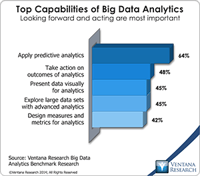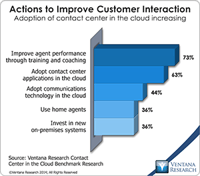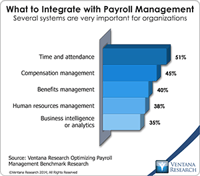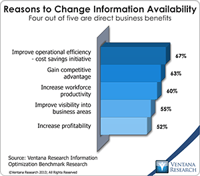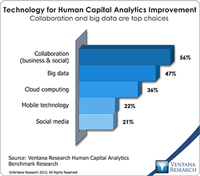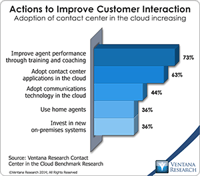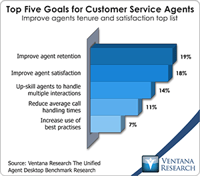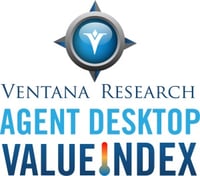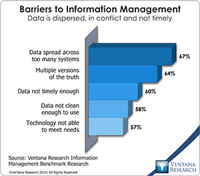Alteryx has released version 9.0 of Alteryx Analytics that provides a range of data to predictive analytics in advance of its annual user conference called Inspire 2014. I have covered the company for several years as it has emerged as a key player in providing a range of business analytics from predictive to big data analytics. The importance of this category of analytics is revealed by our latest benchmark research on big data analytics, which finds that predictive analytics is the most...
Read More
Topics:
Big Data,
Sales Performance,
Social Media,
Supply Chain Performance,
alteryx,
data blending,
IT Performance,
Operational Performance,
Analytics,
Business Analytics,
Business Intelligence,
Business Performance,
Customer & Contact Center,
Financial Performance,
Information Management,
Location Intelligence,
Operational Intelligence
InContact has cloud-based products that cover multichannel communications infrastructure (sometimes referred to as a “contact center in the cloud”) and workforce optimization. The channel management products were developed by inContact and through a partnership with Verint. InContact has been working to make Verint’s workforce optimization products available in the cloud while integrating the two sets of products. I met Kristyn Emenecker, inContact’s VP of workforce optimization, at the recent...
Read More
Topics:
Customer Analytics,
Customer Experience,
Customer Feedback Management,
Speech Analytics,
Voice of the Customer,
Analytics,
Business Analytics,
Business Collaboration,
Cloud Computing,
Customer & Contact Center,
Customer Service,
Call Center,
Contact Center,
Contact Center Analytics,
Desktop Analytics,
Text Analytics,
Workforce Force Optimization
Ultimate Software is one of the larger players in the market for human capital management (HCM) software, with roots in providing human resources and payroll management products. Recently I attended its annual Connections conference. Last year the company focused attention on expansion of its global capabilities, which I analyzed, while this year it highlighted broadening and modernizing of the product suite.
Read More
Topics:
Mobile,
HCM,
Office of Finance,
Recruiting,
Ultimate Software,
Business Collaboration,
Workforce Performance,
Compensation,
HRMS,
Talent Management,
HR Management
I recently attended the 2014 global analyst summit in San Francisco hosted by Pitney Bowes, an old technology company (now in business for 94 years) that has a new focus in its software along with an entirely new executive team. These leaders unveiled a business and technology strategy meant to demonstrate the company’s commitment to software. For many years it has been known mostly for mail services and postage metering, but Pitney Bowes also has made investments in software that can help...
Read More
Topics:
Big Data,
Sales Performance,
Social Media,
Pitney Bowes,
IT Performance,
Operational Performance,
Business Analytics,
Business Intelligence,
Business Performance,
Cloud Computing,
Customer & Contact Center,
Information Applications,
Information Management,
Location Intelligence
At Saba’s recent global customer conference executives discussed the company’s latest product enhancements, progress made during the past year and plans for the future. Saba provides a talent management suite that includes all capabilities except compensation management and is a leading vendor of corporate learning management systems. The majority of its 2,200 customers and 31 million users in 195 countries use the learning system, Learning@Work.
Read More
Topics:
Big Data,
Mobile,
Social Media,
HCM,
Human Capital Management,
Predictive,
Recruiting,
Learning Management,
Analytics,
Business Analytics,
Business Collaboration,
Business Intelligence,
Cloud Computing,
Collaboration,
Saba,
Talent Management
I recently presented at the 2014 ICMI Contact Center Expo and Conference and have a few insights I want to share. I was impressed by the two main keynote speeches. In the first Bill Rancic, an entrepreneur, author and TV personality, talked about “How to Succeed in Business and Life.” Bill is not in the contact center industry, but he reminded the audience that individuals and companies that succeed in life and business grab opportunities when they come along. He went on to say that consumers...
Read More
Topics:
Social Media,
Customer Analytics,
Customer Experience,
Customer Feedback Management,
Social CRM,
Speech Analytics,
Voice of the Customer,
Mobile Apps,
Self-service,
Analytics,
Cloud Computing,
Collaboration,
Customer & Contact Center,
Customer Service,
Call Center,
Contact Center,
Contact Center Analytics,
CRM,
Desktop Analytics,
Text Analytics,
Unified Communications,
Workforce Force Optimization
On its website Panviva describes itself as providing “business process guidance,” which is a phrase I was notfamiliar with. As I searched the site, I found messages such as”it’s all about customer experience,” “the right information for the right person at the right time” and “navigating complexity.” All of these describe issues contact center agents face on a daily basis, and I concluded that Panviva competes in a space I track. My benchmark research into the agent desktop and its impact on...
Read More
Topics:
Customer Experience,
Mobile Apps,
Self-service,
Operational Performance,
Analytics,
Cloud Computing,
Collaboration,
Customer & Contact Center,
Customer Service,
Business Process Management,
Call Center,
Contact Center
My benchmark research into the smart agent desktop finds that in nearly two-thirds (65%) of companies, contact center agents have to access multiple systems as they try to resolve customer interactions. These range from channel management systems (such as telephone, email, text messages and social media) to business applications (such as CRM, ERP and knowledge management), performance dashboards and analysis, and messaging systems. Having to use all these systems leads agents to make mistakes,...
Read More
Topics:
Sales Performance,
Social Media,
Customer Experience,
Mobile Apps,
Self-service,
Operational Performance,
Analytics,
Cloud Computing,
Collaboration,
Customer & Contact Center,
Customer Service,
Call Center,
Contact Center,
Workforce Force Optimization
From my perspective, Infor’s strategy to accelerate revenue growth is to offer companies more innovation and a lower and more predictable cost of ownership than its rivals in the business software market; its products include the major categories of ERP, human resources and financial performance management. It aims to innovate by focusing on improving the user experience and to lower costs by redesigning its software architecture. The innovation stems from a fresh approach to designing...
Read More
Topics:
Microsoft,
Mobile,
SaaS,
Sales,
Sales Performance,
Supply Chain Performance,
Customer Experience,
ERP,
HCM,
Human Capital,
Office of Finance,
Dynamics AX,
Dynamics GP,
Dynamics NAV Dynamics SL,
Sage Software,
UI,
Unit4,
Operational Performance,
Analytics,
Business Analytics,
Business Collaboration,
Business Performance,
Cloud Computing,
Customer & Contact Center,
Financial Performance,
Information Management,
Workforce Performance,
CFO,
FinancialForce,
HR,
Infor,
Workday,
Financial Performance Management,
FPM,
Plex
